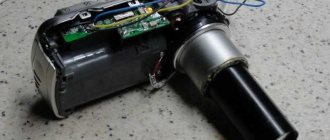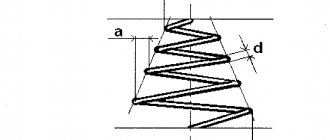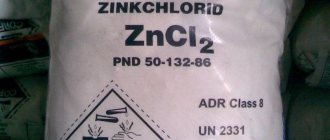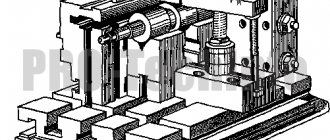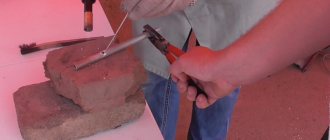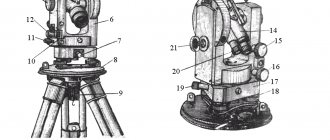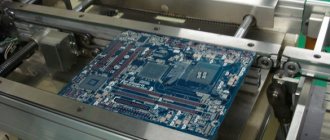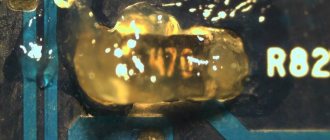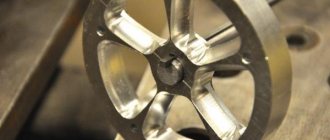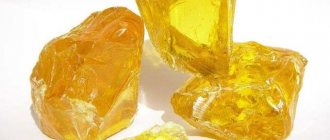Digital microscope from web camera
14:56, April 20, 2021 9 0 2188
Everyone has long known that the entire surrounding world has a subtle organization in its structure, the structure of which cannot be discerned by the human eye. The entire universe remained inaccessible and unknown for a long time until scientists invented a microscope. We all know what a microscope is since school.
In it we looked at bacteria, living and dead cells, objects and objects that we all see every day. Through a narrow viewing lens, they miraculously turned into models of lattices and membranes, nerve plexuses and blood vessels. At such moments you realize how big and multifaceted this world is.
Recently, microscopes have begun to be made digital. They are much more convenient and efficient, because now you don’t have to look closely at the lens. Just look at the monitor screen, and we see an enlarged digital image of the object in question.
Imagine that you can make such a miracle of technology with your own hands from an ordinary webcam. Don't believe me? We invite you to verify this with us.
Necessary resources for making a microscope
- Perforated plate, corner and brackets for fastening wooden parts;
- A section of profile pipe 15x15 and 20x20 mm;
- Small fragment of glass;
- Webcam;
- LED flashlight;
- M8 bolt with four nuts;
- Screws, nuts.
Tools:
- Electric drill or screwdriver with a 3-4 mm drill bit;
- Pliers;
- Phillips screwdriver;
- Hot glue gun.
Step-by-step instructions for assembling a digital microscope
For the tripod base of the microscope we use perforated plates and metal corners. They are used to join wooden products. They are easily bolted together, and many holes allow this to be done at the required level.
Step one - install the base
We cover the flat perforated plate on the back side with soft furniture pads. We simply glue them on the corners of the rectangle.
Self-adhesive for tracks
The next element will be a bracket or corner with versatile shelves. We fasten the short shelf of the bracket and the base plate with a bolt and nut. We tighten them with pliers for reliability.
We mount two small brackets on the edge of the plate on both sides. We attach two more longer corners to them so that we form a small frame. This will be the base for the microscope viewing glass. It can be made from a small piece of thin glass.
Step two - make a tripod
We make a tripod from a piece of square profile pipe 15x15 mm. Its height should be about 200-250 mm.
There is no point in doing more, since exceeding the distance from the viewing glass reduces the quality of the image, and less risks being overexposed and incorrect.
We attach the tripod to a perforated bracket, and on top of it we place a small piece of 20x20 pipe so that it moves freely along this stand.
We make an open frame from two brackets overlapped with each other. We choose longer bolts so that they are enough to tighten this frame around the moving section of the pipe. We place a plate with two holes on the sides on them and secure it with nuts.
To adjust the distance of the frame from the viewing glass, use an M8x100 mm bolt. We will need two nuts to fit the bolt size, and two larger ones. We take epoxy glue and glue the bolt nuts to the tripod in three places. A nut screwed onto the end of a bolt can also be secured with epoxy.
Step three - making the lens
In place of the tube with an eyepiece in our microscope there will be a regular webcam. The higher the resolution, the better; the connection to a computer can be either wired (USB 2.0, 3.0), or via Wi Fi or Bluetooth. We free the camera from the body by unscrewing the motherboard with the matrix with a screwdriver.
We remove the protective cap and unscrew the lens with lenses and filter. All you need to do is place it in the same place, turning it 180 degrees.
We wrap the junction of the camera lens with the cylindrical body with electrical tape. If desired, it can be additionally glued with a hot glue gun. At this stage, the modified lens can already be tested in action.
Step four - final assembly of the microscope
We assemble the camera in reverse order, placing its body on the tripod frame with hot glue. The lens should be pointed downwards at the viewing glass of the microscope. The wiring harness can be secured with nylon ties to the tripod stand.
We adapt a low LED flashlight to the sight glass illuminator. It should fit freely under the microscope viewing panel. We connect the camera to the computer, and after a while the image will appear on the monitor screen.
The assembly is ready, it can be checked on any object, for example, by examining the crystal lattice of a pencil lead or the pixel structure of the screen of your smartphone.
A popular trend today is the use of such homemade or inexpensive microscopes to control the soldering of small parts on electronic boards.
Your child will undoubtedly like it, and perhaps awaken an interest in learning about the world around us.
Source: //sam-sebe-master.info/cifrovoj-mikroskop-iz-veb-kamery/
Top 9 best microscopes for soldering
Dear readers, below is an overview for selecting microscopes for soldering and repairing electronics, SMD components, microcircuits, and repairing cell phones.
9th place – microscope
Arstek AD106206
This microscope is perfect for observing convex or recessed parts of objects, identifying cracks in microcircuits or performing soldering. The presence of a 7-inch LCD screen included with the microscope eliminates the need to purchase an additional monitor for image visualization.
Magnification 0 – 200 times, 2 megapixel camera, LED backlight. There is the possibility of retrofitting a MicroSD memory card.
Taken together, this microscope is ideal for entry-level soldering.
Budget digital electron microscope for checking electronics, circuit boards, identifying microcracks in soldering, checking and soldering microcircuits, and repairing mobile cell phone circuit boards. High quality and clarity of images with a 1/3” CMOS camera matrix and a resolution of 1280 * 720 at 60 fps. A connection via HDMI allows you to either purchase and install a display on a microscope stand, or connect it to an existing monitor/TV/projector, etc.
The ability to adjust brightness, contrast, saturation from 0 to 100%, automatic or manual white balance and a number of other features allows us to confidently place this microscope in 8th place in our rating.
This microscope configuration boasts a good camera with smooth and fast motion transmission, low latency, high quality and clarity of images. The camera has a Panasonic CMOS sensor 1/2.3'', 37 megapixels. The camera can shoot in 1920 * 1080 resolution at 60 fps.
It is also suitable for testing electronics, circuit boards, identifying microcracks in soldering, testing and soldering microcircuits, and repairing circuit boards of mobile cell phones.
6th place – microscope
Arstek 180 xZoom6.5 HDMI
A mid-budget microscope with an excellent camera, high resolution and image clarity. SONY IMX307 CMOS 1/2.8'' sensor, shooting in resolution 1920 * 1080 or 1024 * 768 at 60 fps.
Possibility to choose from 4 configuration options.
1) Digital microscope with camera and ring illuminator
2) Digital microscope with camera, ring illuminator and LCD screen
3) Digital microscope with camera, ring illuminator and flexible light guides
4) Digital microscope with camera, ring illuminator, flexible light guides and LCD screen
5th place – microscope
Arstek 180 xZoom6.5 HDMI- USB
In this version, you need to pay special attention to the camera. Sensor Panasonic CMOS 1/2.3'', 37 megapixels. The camera can shoot in 1920 * 1080 resolution at 60 fps. HDMI and USB2.0 outputs.
HDMI image resolution: 8168*6128 4:3 (50MP) 8168*4592 16:9 (37MP) (for TF card),
USB Image Resolution: 1920*1080 (for PC USB)
4th place – microscope
Arstek StereoZoom6.43 x
Professional binocular stereo microscope with 7x-45x magnification. Ideal for all industrial electronics and educational inspection, anatomy, biology, agriculture seed selection, jewelry appraisal and textile inspection, for gemologists, engraving work, PCB inspectors in the semiconductor and/or electronics industry. When retrofitting, it is possible to display the image on a monitor and purchase eyepieces of the required magnification (10X/20 mm, 15X/15 mm, 20X/10 mm).
A working distance of 100 mm allows you to conveniently position the object and carry out various manipulations with it. The ability to adjust the interpupillary distance is also a big plus.
3rd place – microscope OLYMPUS SZ4045
Professional binocular stereo microscope with 6.7x-40x magnification.
The larger working distance relative to the 4th place, 110 mm, as well as the possibility of increasing the working distance to 165 mm when using a Barlow lens, makes this model convenient to use if your research objects are large.
2nd place – Arstek Z7 microscope for control
This model of digital electron microscope is suitable for visual inspection of electronics, circuit boards, microcircuits, soldering quality, microcracks, and quality control. Supports online high-speed measurements, the ability to view samples, take high-quality photos, also for short soldering from time to time.
Camera 4MP, 1/3″, image resolution up to 2688 * 1520. Built-in 16GB of memory, SD, USB connectivity.
You can also connect a wireless mouse, external monitor and personal computer, USB flash drive or hard drive, WIFI. The variable-angle screen is very convenient to use.
All these parameters allow us to put this model in second place in our rating list.
1st place – OLYMPUS SZ61 microscope
Professional binocular stereomicroscope. One of the best repair microscopes with 6.7x-45x magnification. Ideal for all industrial electronics and educational inspection, anatomy, biology, agriculture seed selection, jewelry appraisal and textile inspection, for gemologists, engraving work, PCB inspectors in the semiconductor and/or electronics industry.
Magnification range 2 – 270x when retrofitted with various Barlow lenses. Variety of eyepieces: 10x, 15x, 20x, 30x. Working distance 110 mm. Smooth change of magnification. All these parameters, combined with an excellent design, allow us to put this microscope in first place in the rating.
DIY microscope: master class on making an electronic device
A microscope is needed not only for studying the surrounding world and objects, although this is so interesting! Sometimes this is just a necessary thing that will make it easier to repair equipment, help make neat solders, and avoid mistakes in fastening miniature parts and their exact location. But it is not necessary to purchase an expensive unit. There are great alternatives. What can you make a microscope from at home?
Microscope from a camera
One of the simplest and most affordable ways, but with everything you need. You will need a camera with a 400 mm, 17 mm lens. There is no need to disassemble or remove anything, the camera will remain working.
We make a microscope from a camera with our own hands:
- We connect a 400 mm and a 17 mm lens.
- We bring a flashlight to the lens and turn it on.
- We apply a drug, substance or other micro-subject of study to the glass.
We focus and photograph the object under study in an enlarged state. The photo from such a homemade microscope turns out to be quite clear; the device can enlarge hair or fur, or onion scales. More suitable for entertainment.
Microscope from a mobile phone
The second simplified method for making an alternative microscope. You need any phone with a camera, preferably one without auto focus. Additionally, you will need a lens from a small laser pointer. It is usually small, rarely exceeding 6 mm. It is important not to scratch.
We fix the removed lens on the camera eye with the convex side outward. We press it with tweezers, straighten it, you can make a frame around the edges from a piece of foil. It will hold a small piece of glass. We point the camera with the lens at the object and look at the phone screen. You can simply observe or take an electronic photograph.
If you don’t currently have a laser pointer at hand, you can use the same method to use a sight from a children’s toy with a laser beam; you just need the glass itself.
Microscope from a webcam
Detailed instructions for making a USB microscope from a webcam. You can use the simplest and oldest model, but this will affect the image quality.
Additionally, you need optics from a sight from a children's weapon or other similar toy, a tube for the sleeve and other small items at hand. For backlighting, LEDs taken from the old laptop matrix will be used.
Making a microscope from a webcam with your own hands:
- Preparation. We disassemble the camera, leaving the pixel matrix. We remove the optics. Instead, we fix a bronze bushing in this place. It should match the size of the new optics; it can be turned from a tube on a lathe.
- The new optics from the sight must be secured in the manufactured sleeve. To do this, we drill two holes approximately 1.5 mm each and immediately make threads on them.
- We stick in the bolts, which should follow the threads and match in size. Thanks to screwing, you can adjust the focus distance. For convenience, you can put beads or balls on the bolts.
- Backlight. We use fiberglass. It's better to take double-sided. We make a ring of the appropriate size.
- For LEDs and resistors you need to cut small tracks. We solder it.
- Installing the backlight. To fix it, you need a threaded nut, the size is equal to the inside of the manufactured ring. Solder.
- We provide food. To do this, from the wire that will connect the former camera and the computer, we bring out two wires +5V and -5V. After which the optical part can be considered ready.
You can do it in a simpler way and make a stand-alone light from a gas lighter with a flashlight. But when it all works from different sources, the result is a cluttered design.
To improve your home microscope, you can build a moving mechanism. An old floppy drive will work just fine for this. This is a once used device for floppy disks. You need to disassemble it, remove the device that moved the read head.
If desired, we make a special work table from plastic, plexiglass or other available material. A tripod with a mount will be useful, which will facilitate the use of a homemade device. Here you can turn on your imagination.
There are also other instructions and diagrams on how to make a microscope. But most often the above methods are used. They may vary only slightly depending on the presence or absence of key parts. But, the need for invention is cunning, you can always come up with something of your own and show off your originality.
Source: //tytmaster.ru/mikroskop-svoimi-rukami/
Upgrade a point-and-shoot to a microscope
In this topic I’ll tell you how I made a tool for microphotography from an old digital camera and a lens from a CD-ROM.
So, it all started with the fact that in the process of implementing the idea, various variations of the camera (Olympus C-350) with lenses from CD-ROM, DVD-ROM and a couple of others, taken from different optics, were tried. In terms of magnification and image quality, CD and DVD-ROM lenses were close, but in the end the CD lens was chosen due to its more convenient design (it was easier to make a frame for it).
In the photo on the right, this lens (not to be confused with the ashtray) was photographed through another lens, which has a longer focal length and is therefore more suitable for macro photography.
To attach the lens to the camera lens, I made a frame out of foam plastic and colored it with a black marker to make it more opaque:
Already at the beginning of the experiments, it became clear that holding a digital camera in your hands would not allow you to take a high-quality photo due to strong vibration, so a tripod with hydraulic focusing was made from scrap materials over the course of the evening (it sounds like a damn thing).
The stand is assembled from a piece of plastic pipe as a frame, two syringes of different diameters, a syringe with a larger diameter is used to attach the object stage to it, and a syringe with a smaller diameter is used to control the movement of the object stage. The table itself is cut from a CD case. To secure the whole thing to the table, I found a mounting bracket. I made 2 holes in the plastic tube, on the top for the bolt that secures the camera (by the way, an ordinary furniture bolt, which I borrowed from the table for the sake of science, worked perfectly), and on the bottom for the mounting bracket. I connected the syringes using a dropper, filling the whole thing with water. The large syringe was, without further ado, taped to the tube.
The end result is this tripod:
Now we screw the soap dish to the tripod and the device is ready for microphotography!
I apologize for the quality of the photo, I had to use my phone.
Here are a few photos that were taken during testing of the device:
Photos of LCD matrices, Nokia E51 on the left, HP iPAQ hx2190 on the right. The vile Chinese spared LCD molecules for Nokia)
Hair from my head (it turned out so creative due to the need for side lighting)
And the classic - onion cells.
According to my profane calculations (I compared the real pixel size and its size in the photograph), the magnification reaches x500, although, of course, the useful magnification is less. I take photographs without flash, illuminating the subject with a flashlight. In order to eliminate vibrations when releasing the shutter, I use the shooting delay function. It’s a pity that the C350 doesn’t have autofocus off, because... Having fine-tuned the focus using syringes, autofocus throws it off a little. The quality of shooting also deteriorates significantly due to spherical aberration, but my knowledge of optics was only enough to add an aperture, which did not provide a noticeable improvement. Another disadvantage is that photographs of opaque objects turn out poorly, due to the fact that you have to illuminate them from the side, which leads to such consequences as in a photograph of a hair.
PS In the process of searching for a blog to publish, I came across a post describing a similar combination of “telephone camera + DVD lens”, but I did not refuse to publish it, after all, it describes not micro, but macro photography.
Top 5 best microscopes for soldering
Friends! Welcome to Master Soldering Light! Today I will give you my Top 5 best microscopes for soldering. I will tell you not only about foreign microscopes for repair.
There will also be information about digital microscopes that you can make with your own hands from a USB webcam, an old camera or a mobile phone. And now I will give the criteria by which this rating was arranged and the best microscope for soldering microcircuits was selected.
First of all, this is image quality, ease of use and, of course, price-quality ratio.
At the end, I will give a review of a microscope for soldering microcircuits and a method for attaching a microscope to a desktop, long ago and kindly provided by Master Sergei.
5th place - microscope for do-it-yourself soldering
We’ll start with electronic video microscopes made with our own hands from a webcam or an old camera. Such microscopes are widely used by non-professionals and novice craftsmen.
The image quality from them leaves much to be desired. And a time delay can negate all the heroic achievements of the repairman. Often such microscopes do not have enough magnification power. Most often it is 10x-30x, like in children's microscopes.
Let me remind you that for comfortable soldering under a microscope, its magnification factor should be about 20x-40x with a working distance of 180-190 mm.
How to make a digital microscope from a webcam
It’s quite easy to make a digital USB microscope from a web camera for soldering yourself - you just need to replace the optics with a shorter focal length one. Sometimes the technique of flipping the original lens 180 degrees works. In this case, the optimal distance to the matrix is additionally selected. Usually it is 2-3 mm.
You can also use optics from children's toys: a sight or a photo enlarger. It is better to choose a soldering chamber with a higher resolution and smaller dimensions. This will make it more convenient to work with it during soldering and repairs.
As you can see, a USB microscope from a web camera for soldering is quite easy to make from scrap materials within a few hours. For this you will need :
- Webcam;
- soldering iron with solder and flux;
- screwdrivers;
- tripod spare parts;
- backlight LEDs, if they are not in the camera;
- glue or epoxy resin;
- program for broadcasting images to an LCD monitor.
This is the design of a homemade microscope from an SMD inspection chamber that can be obtained.
Disadvantages of a microscope using a web camera:
- a large delay of the video signal, and therefore inconvenient soldering;
- low video frame resolution (most often 640 x 480 pixels);
- you have to do the tripod, lighting and positioning yourself;
- A computer or laptop is required next to the camera.
Advantages of a microscope from a webcam:
- you can use an old but working webcam;
- this is the cheapest option, usually made at home;
- there is a field for creativity and imagination;
- suitable for visual diagnosis of microcracks in soldering;
- with native inverted optics, magnification is 10x-20x.
The following video is devoted to the principle of making a microscope from a webcam with your own hands. A tripod was used and a video of the soldering process of the USB connector is shown.
Microscope from a camera
To be honest, this “microscope” looks quite strange. The principle is the same as with a webcam - the optics are turned 180 degrees. There are even special reversing adapters for SLR cameras.
Below you can see the image obtained from such a homemade microscope for soldering. A large depth of field is visible - this is normal.
Disadvantages of such a homemade microscope:
- short working distance;
- large dimensions;
- You need to come up with a way to mount the camera comfortably.
Advantages of a photo camera for soldering
- can be made from an existing SLR camera;
- magnification is smoothly adjustable;
- there is autofocus.
Microscope from a mobile phone
The most popular way to make a microscope from a mobile phone with your own hands is to screw a lens from a CD or DVD player to the smartphone camera. This is the design of the microscope.
Lenses in this technique are used with a very short focal length. Therefore, using such a microscope, you can only monitor the state of soldering of SMD components and look for microcracks in the solder. You simply cannot get a soldering iron between the board and the lens. Below is a video that shows what magnification such a homemade microscope gives.
Another option is a microscope on a clip for a mobile phone. This thing looks like this and costs just a penny.
In more advanced cases, a mobile phone is hung on an existing stereo or mono microscope for soldering small parts. I got some good pictures this way. This method is important when photomicrographs need to be taken for training or consultation with other artists.
4th place - USB microscope for soldering
Chinese USB microscopes are now popular, essentially made from 2 Mpix and 13 Mpix web cameras or even with a built-in monitor, for example the G600 and Andonstar ADSM301 USB microscopes. Such electron microscopes are more intended for visual diagnostics of electronics, video inspection of soldering quality, or, for example, for checking the sharpness of knives.
Let me remind you that the video signal delay in such microscopes is significant. With a built-in monitor it is much easier to solder, but there is no depth of field and three-dimensional perception of micro-objects.
Disadvantages of a USB microscope:
- temporary lags that do not allow quick soldering;
- low optical resolution;
- lack of volumetric perception;
- As a rule, this is a stationary option, connected to a computer or outlet.
Advantages of a USB microscope:
- the ability to work at a comfortable eye distance;
- you can take videos and photos;
- relatively low cost;
- low weight and dimensions;
- You can easily look at the board at an angle.
See the video reviewing a cheap USB microscope below.
3rd place - Chinese microscope for soldering
Microscopes designed for soldering are binocular and trinocular microscopes.
I will say right away that all the products of the frequently offered YaXun company are an attempt to reduce the cost of the microscope by reducing quality. Plastic lenses and poor alignment of the eyepieces prevent soldering under them for a long time.
At least, almost all of the Master’s acquaintances who had such microscopes complained about their health. There were messages in which people took optics from the MBS series and installed them on YaXun - somehow it helped.
Trinocular microscopes Minsvision, Fyscope, Luckyzoom SZM45 and Omano OM2300S are quite popular.
Reviews about them are quite good. Both of them are certainly not role models, but they look impressive. The image quality is good, the working distance is 100 or 200 mm depending on the attachments. These microscopes can be used for soldering with proper setup and care.
See the mini-review in the video, the image through the lens is shown at the 9th minute.
2nd place - imported microscope for soldering
Among foreign brands, Carl Zeiss, Reichers, Tamron, Leica, Olympus, Nikon are famous for microscope equipment.
Models such as Nikon SMZ-1, Olympus VMZ, Leica GZ6, Olympus SZ3060, Olympus SZ4045ESD, Nikon SMZ-645 have rightfully earned the title of folk binocular microscopes for soldering for their image quality.
Below are approximate prices for popular foreign models :
- Leica s6e/s4e (7-40x) 110 mm - $1300;
- Leica GZ6 (7x-40x) 110 mm - $900;
- Olympus sz4045 (6.7x-40x) 110 mm - $500;
- Olympus VMZ 1-4x 10x 90 mm - $500;
- Nikon SMZ-645 (8x-50x) 115 mm - $800;
- Nikon SMZ-1 (7x-30x) 100 mm - $400;
- good Nikon SMZ-10a - $1500.
In principle, the prices are not astronomical, but these are used microscopes that can be bought on eBay or Amazon with paid delivery. The benefit here needs to be considered in each particular case separately.
1st place - domestic microscope for soldering
Among truly domestic microscopes, LOMO and they make applied microscopes under the SME brand. The most suitable for soldering is MSP-1 option 23. True, the price tag for the new one is not for children.
I have to say that Altami, Biomed, Micromed, Levenhuk are all domestic sellers of Chinese microscopes. Many people complain about the quality of workmanship.
We do not consider them for professional use. True, there are tolerable specimens. This depends on the conditions of transportation and storage.
The fact is that their optics are adjusted using silicone glue with appropriate reliability.
From old stocks or used, truly Soviet ones can be taken on Avito:
- BM-51-2 8.75x 140 mm - 5 thousand rubles. play around;
- MBS-1 (MBS-2) 3x-100x 65 mm - up to 20 thousand rubles;
- MBS-9 3x-100x 65 mm - up to 20 thousand rubles;
- OGME-P3 3x-100x 65/190mm - up to 20 thousand rubles. (I have one at work, I like it);
- MBS-10 3x-100x 95 mm - up to 30 thousand rubles;
- BMI-1Ts 45x 200 mm - more than 200 thousand rubles. - measuring.
Results of the microscope rating
Let's summarize the rating of microscopes for soldering microcircuits:
If you are still thinking about which microscope to choose for soldering, then my winner is MBS-10 - the people's choice for many years now.
microscopes according to purpose
This rating is taken from this microscope specialist and has been significantly condensed for ease of reading.
Microscope for mobile phone repair
The following microscopes for soldering mobile phones are sorted by degree of image quality magnification:
- MBS-10 (low contrast, unrealistic colors at high magnifications, discrete switching of magnifications, 90 mm distance);
- MBS-9 (65 mm distance and low contrast);
- Nikon SMZ-2b/2t 10cm (8x-50x)/(10-63x);
- Nikon SMZ-645 (8x-50x) 115 mm;
- Leica s6e/s4e (7-40x) 110 mm;
- Olympus sz61 (7-45x) 110 mm;
- Leica GZ6 (7x-40x) 110 mm;
- Olympus sz4045 (6.7x-40x) 110 mm;
- Olympus VMZ 1-4x 10x with a working distance of 90 mm;
- Olympus sz3060 (9x-40x) 110 mm;
- Nikon SMZ-1 (7x-30x) 100 mm;
- Bausch and Lomb StereoZoom 7 (working distance only 77 mm);
- Leica StereoZoom 7;
- Nikon SMZ-10a with Nikon Plan ED 1x lens and 10x/23 mm eyepieces;
- Nikon SMZ-U (7.5x-75x) working distance with Nikon Plan ED 1x 85 mm, with original 10x/24 mm eyepieces.
Microscope for repairing tablets and motherboards
For such applications, the issue of maximum resolution is not so important; magnifications of 7x-15x work there. They require a good universal tripod and a low minimum magnification. The following microscopes for soldering motherboards and tablets are sorted by degree of image quality magnification:
- Leica s4e/s6e (110mm) with 35mm field;
- Olympus sz4045/sz51/sz61 (110mm) with a field of 33 mm;
- Nikon SMZ-1 (100mm) with a field of 31.5 mm;
- Olympus sz4045;
- Olympus sz51/61;
- Leica s4e/s6e;
- Nikon SMZ-1.
Microscope for a jeweler or dental technician
The following microscopes for dental technicians or jewelers with a long working distance are sorted by degree of image quality magnification:
- Nikon SMZ-1 (7x-30x) with 10x/21 mm eyepieces;
- Leica GZ4 (7x-30x) 9 cm with 0.5x lens (19 cm);
- Olympus sz4045 150 mm;
- Nikon SMZ-10 150 mm.
Microscope for engraving
The following deep depth of field engraving microscopes are sorted by image quality magnification:
- Nikon SMZ-1;
- Olympus sz4045;
- Leica gz4.
How to check a used microscope when purchasing
Before purchasing a used microscope for soldering, it is easy to check (partially taken from this specialist):
- Inspect body for scratches and signs of impact. If there are signs of impact, the optics may be knocked off.
- check the play of the positioning knobs - there should not be any.
- Mark a small dot on a piece of paper with a pencil or pen and check if the dot doubles at different magnifications.
- When turning the microscope adjustment knobs, listen for any crunching or slipping sounds. If they are, the plastic gears may be broken and they are not sold separately.
- inspect the eyepieces for anti- reflection . It is often scratched or erased due to improper care.
- rotate the eyepieces around their axis on a white background. If image artifacts are also spinning, then the problem is dirt on the eyepieces - that’s half the problem.
- If gray spots , faded images or dots are visible, the prism or auxiliary optics may be dirty. Sometimes a whitish coating, dust and even fungus are found on it.
- The most difficult thing in diagnosing a soldering microscope is to determine weak vertical misalignment If it is difficult for your eyes to adapt to the image in a couple of minutes, then it is better not to take such a microscope for soldering - it has severe misalignment. If, when soldering under a microscope, your eyes get tired within 30-60 minutes and your head starts to hurt, then this is weak ignorance. Slight differences in height between objects are difficult to determine when purchasing.
- inspect the spare parts, if available.
How to mount a microscope on your desktop
There are many ways to mount a soldering microscope to your workbench. Manufacturers solve these problems with a solid base and rod. They keep the microscope from falling and make it easy to position it relative to the board.
A homemade microscope stand or tripod is usually made from an old photographic enlarger or other available resources and parts.
But Master Sergei made a microscope stand for soldering microcircuits with his own hands from furniture tubes. It turned out well. For a review of his Fyscope microscope with mount, see below.
Source: //masterpaiki.ru/top-5-luchshih-mikroskopov-dlya-payki.html
Assortment of microscopes for soldering
The use of new technologies has made magnifying equipment accessible and convenient. Everyone can choose and buy a USB microscope that is ideal for them both in functionality and cost. Electronic or optical binocular microscopes are usually chosen for workshops. If your budget allows, you can choose a universal microscope for soldering microcircuits, which can simultaneously be used as both a binocular and an electronic one.
For soldering and other types of fine work, devices with:
- slight magnification (from 8 to 100 times);
- long focal length (for ease of operation);
- good diffused illumination;
- stereoscopic image.
It is these characteristics that you should pay primary attention to when choosing a microscope for delicate work. If working with stereoscopic images is not important to you, then it is better to choose a digital electron microscope connected to USB. Modern models provide excellent image quality and maximum operating convenience.
How to make a microscope for soldering work
The high level of miniaturization of electronics has led to the need to use special magnifying tools and devices used when working with very small elements.
These include such a common product as a USB microscope for soldering electronic parts and a number of other similar devices.
Accessories and additional parts
Some experts believe that a USB device is optimal for making a household microscope with your own hands, with the help of which it is possible to provide the required focal length.
However, to implement this project, it will be necessary to carry out certain preparatory work, which will greatly simplify the assembly of the device.
As the basis for a homemade microscope for soldering miniature parts and microcircuits, you can take the most primitive and cheapest network camera like “A4Tech”, the only requirement for which is that it has a working pixel matrix.
If you want to obtain high image quality, it is recommended to use higher quality products.
In order to assemble a microscope from a webcam for soldering small electronic products, you should also worry about purchasing a number of other elements that ensure the required efficiency of working with the device.
This primarily concerns the illumination elements of the field of view, as well as a number of other components taken from old disassembled mechanisms.
A homemade microscope is assembled based on a pixel matrix that is part of the optics of an old USB camera. Instead of the built-in holder, you should use a bronze bushing turned on a lathe, adjusted to the dimensions of the third-party optics used.
The corresponding part from any toy sight can be used as a new optical element of the microscope for soldering.
To get a good overview of the desoldering area and soldering parts, you will need a set of lighting elements, which can be used as used LEDs. It is most convenient to remove them from any unnecessary LED backlight strip (from the remains of a broken matrix of an old laptop, for example).
Finalization of details
An electron microscope can begin to be assembled only after thoroughly checking and finalizing all previously selected parts. The following important points should be taken into account:
- to mount the optics in the base of the bronze bushing, you need to drill two holes with a diameter of approximately 1.5 millimeters, and then cut a thread into them for an M2 screw;
- then bolts corresponding to the installation diameter are screwed into the finished holes, after which small beads are glued to their ends (with their help it will be much easier to control the position of the optical lens of the microscope);
- then you will need to organize illumination of the soldering field of view, for which you will need previously prepared LEDs from the old matrix.
Adjusting the position of the lens will allow you to arbitrarily change (decrease or increase) the focal length of the system when working with a microscope, improving soldering conditions.
To power the lighting system, two wires are provided from the USB cable that connects the webcam to the computer. One is red, going to the “+5 Volt” terminal, and the other is black (it is connected to the “-5 Volt” terminal).
Before assembling the microscope for soldering, you will need to make a base of a suitable size. It is useful for wiring LEDs. For this, a piece of foil fiberglass, cut in the shape of a ring with pads for soldering LEDs, is suitable.
Assembling the device
Quenching resistors with a nominal value of about 150 Ohms are placed in the breaks in the switching circuits of each of the lighting diodes.
To connect the supply wire, a mating part made in the form of a mini-connector is mounted on the ring.
The function of a moving mechanism that allows you to adjust the sharpness of the image can be performed by an old and unnecessary floppy disk reader.
You should take one shaft from the motor in the drive and then reinstall it on the moving part.
To make it more convenient to rotate such a shaft, a wheel from an old “mouse” is put on its end, located closer to the inside of the engine.
After the final assembly of the structure, a mechanism should be obtained that ensures the required smoothness and accuracy of movement of the optical part of the microscope. Its full stroke is approximately 17 millimeters, which is quite enough to sharpen the system under various soldering conditions.
At the next stage of assembling the microscope, a base (worktable) of suitable dimensions is cut out of plastic or wood, on which a metal rod selected in length and diameter is mounted. And only after that the bracket with the previously assembled optical mechanism is fixed on the stand.
